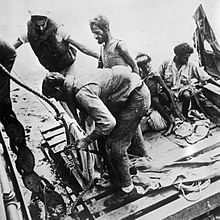Zaandam (ship, 1939)
|
||||||||||||||||||||||
|
||||||||||||||||||||||
|
||||||||||||||||||||||
|
||||||||||||||||||||||
The Zaandam (II) was a 1939 passenger and cargo ship of the Dutch shipping company Holland-America Line , which was sunk by a German submarine in the South Atlantic on November 2, 1942 . 134 passengers and crew members were killed.
The ship
The 10,909 GRT motor ship was laid down in 1937 under the name Schiedam at the NV Dok en Werf Maatschappij Wilton-Fijenoord shipyard in Schiedam and completed as Zaandam in 1939 . The 152.9 meter long and 19.6 meter wide ship had a maximum draft of 9.34 meters and was powered by diesel engines that worked on two propellers and made 3359 nominal horsepower (nhp). The top speed was 18 knots. The Zaandam , the sister ship of the Noordam (II) (10,726 GRT), which was completed in 1938 , was designed for 160 passengers and a crew of 123.
Carl Zuckmayer and his family arrived on board the Zaandam at 4 a.m. on June 6, 1939 in New York.
After the outbreak of World War II , the ship was placed in the service of the War Shipping Administration of the US government.
Sinking
On Monday, November 2, 1942, the Zaandam was under the command of Captain Jacob Matthias Stamperius on a crossing from Beira (Mozambique) via Cape Town (South Africa) to New York . The ship left Cape Town on October 21. In addition to 7000 tons of copper and chromite , the ship had loaded a further 600 tons of cargo. On board were 112 crew members, 18 artillerymen from the United States Navy Armed Guard (USNAG) and 169 mostly US passengers. The majority of the passengers were survivors of five merchant ships that had been sunk shortly before Cape Town. Fifteen were from the cargo steamer Coloradan , 40 from the cargo steamer Examelia , 41 from the cargo steamer Chickasaw City , 31 from the tanker Swiftsure and nine from the motor ship Firethorn . The first four sailed under the flag of the USA , the latter under the flag of Panama . Also on board as a passenger was 56-year-old Jan Pieter Wepster, a long-time commander of Holland America ships, who had also been the captain of the Volendam when it was torpedoed by U 60 in August 1940 with evacuated British children on board .
At 6:17 p.m. on November 2, the Zaandam , which was not in a convoy and was pursuing a zigzag course, was torpedoed by U 174 about 300 nautical miles north of the Cabo De São Roque (Brazil) headland . U 174 was a German submarine of the type IX C , which was under the command of Captain Ulrich Thilo on patrol . The torpedo struck the engine room on the port side and caused considerable damage to the decks above. The engines were destroyed by the detonation, the rudder no longer responded and the engine room began to fill up. After the disembarkation had begun, Captain Wepster ordered those who had already boarded to leave the boats. He thought it was just a small explosion in the engine room that would not affect the buoyancy of his ship.
At 6.28 p.m. the submarine fired a catching shot which hit the Zaandam again on the port side and caused her to go down bow first within two minutes . Before the sinking, three lifeboats and two rafts could be lowered into the water. The other boats had been destroyed by the explosions. The occupants of the boats were asked by the submarine crew for the name and destination of the ship. They were also asked why there were so many passengers on board, to which it was replied that they were survivors of other ship sinks.
The survivors
Lifeboat No. 2 capsized and had to be straightened up by the occupants. The blood of the wounded attracted sharks, which claimed several lives. The lifeboats No. 1 (72 survivors) and No. 4 (34 survivors) were picked up by the American tanker Gulfstate on November 7th . Of the 106 rescued, two died on board the ship. Four seriously injured were handed over to the US destroyer Winslow , who brought them to Belém .
Another boat with 60 occupants went ashore on November 10 at Barreirinhas on the coast of the Brazilian state of Maranhão . Two men died there shortly afterwards and were buried in Barreirinhas. A life raft with three survivors was found 84 days after the sinking by the American patrol boat USS PC-576 accompanying a convoy along the coast. They received liquid food on board and then spent six weeks in a hospital in Pernambuco .
The sinking of the Zaandam killed the captain, ten riflemen, 54 crew members and 69 passengers; a total of 134 out of 299 people who were on board. The wreck of Zaandam is in position 1 ° 25 '0 " N , 36 ° 22' 0" W .
Web links
- Ship details and photos
- General details about sinking
- More detailed description of the sinking
- Sinking of the Zaandam and the ships whose survivors she had on board
- The Zaandam in a collection of sunken ships in 1942
Individual evidence
- ↑ Carl Zuckmayer: As if it were a piece from me , Fischer, Frankfurt am Main 1966; Fischer Taschenbuch, Frankfurt am Main 2006, ISBN 978-3-596-17208-5 .

